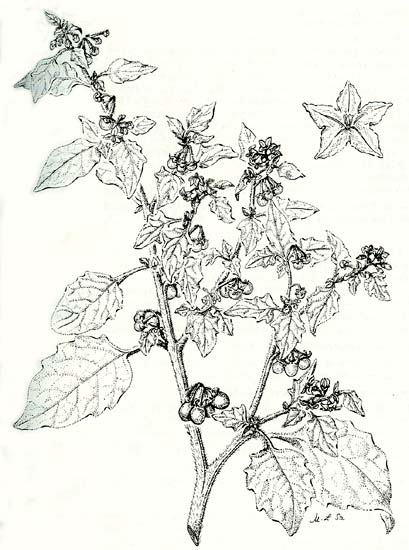 Line drawing by M. Szent Ivany, J. Adelaide Bot. Gard. 4 (1981) 55, fig. 9. |
 Distribution map generated from Australia's Virtual Herbarium . |

Synonymy
*Solanum villosum Miller, Gard. Dict. 8th edn, no. 2 (1768)
T: Cultivated Chelsea Physic Garden, origin Barbados, Miller; lecto: BM n.v., fide J.M. Edmonds, Bot. J. Linn. Soc. 78: 219 (1979), photo AD.
Description
Herb, usually annual, to 70 cm, green, slightly to densely pubescent with glandular or simple, non-glandular hairs; prickles absent.
Leaves ovate, the lamina up to 8 cm long, commonly c. 4 cm, 3–6 cm wide, concolorous, entire or shallowly lobed; petiole to 4.5 cm long.
Inflorescence short, 3–8–flowered; peduncle and pedicels c. 1 cm long. Calyx 1.2–2 mm long; lobes semi-elliptic, 1 mm long. Corolla shallowly incised, 8–15 mm diam., white. Anthers 1.5–2.2 mm long.
Berry almost globular, 5–9 mm diam., dull orange-red. Seeds 1.7–2.3 mm long, pale yellow. n=24.
Distribution and ecology
Widespread weed in Europe, Mediterranean countries, northern Africa and North America. Sparingly naturalised in Qld, S.A. and W.A.
A weed of tobacco crops in Qld.
Common name
Woolly Nightshade
Relationships
Part of the S. nigrum or "Black nightshade" group of species, usually referred to as cosmopolitan weeds and usually thought to have originated in the Americas. They are characterised by their lack of prickles and stellate hairs, their white flowers and their green or black fruits arranged in an umbelliform fashion.
The species can be difficult to distinguish, but this species has orange berries. Other species to occur in Australia are S. americanum, S. chenopodioides, S. furcatum, S. douglasii, S. opacum, S. physalifolium, S. retroflexum, S. sarrachoides, S. scabrum and S. nigrum.
A useful reference to the Black Nightshades is J. M. Edmonds & J. A. Chweya, The Black Nightshades. Solanum nigrum and its related species. Int. Plant. Genetic Res. Inst. Rome (1997).
Notes
Some members of the complex have long been important food and medical sources in parts of Africa,
References: Keller, G.B. (2004). African nightshade, eggplant, spiderflower et al. - production and consumption of traditional vegetables in Tanzania from the farmer's point of view. MSc dissertation,
Selected specimens
S.A.: Strathalbyn, 13 Apr. 1961, D.L. Manisty (AD). Qld: Near Mareeba, R.J. Henderson 1573 (BRI).
From the web
A fact sheet for this species can be downloaded from the SA eFlora site.
One of the edible African nightshades - a fact sheet about growing this plant in Africa can be downloaded at http://www.avrdc.org/LC/indigenous/svillosum.html
A comprehensive fact sheet on S. villosum in
Images of the flower and fruit can be seen at www.maltawildplants.com/SOLN/Solanum_villosum.php
Images of frutis can be seen on the Dave’s Garden site.
The United States Department of Agriculture Germplasm Resources Information Network (GRIN) has numerous links for this species.
Limited information and links for this species are available on the Solanaceae Source site, but there is an image of the fruits.